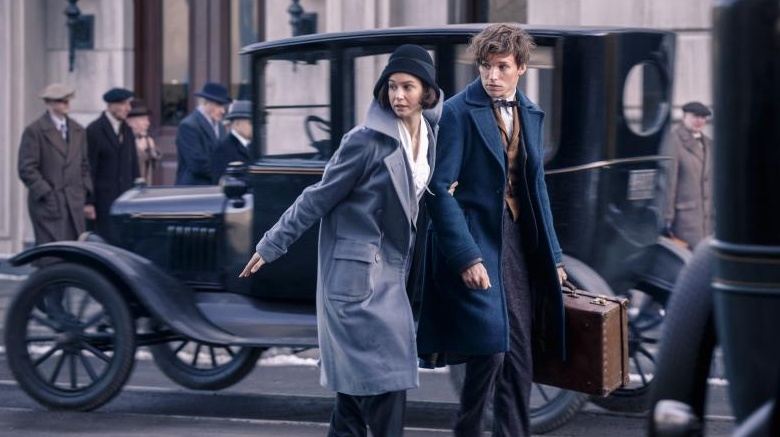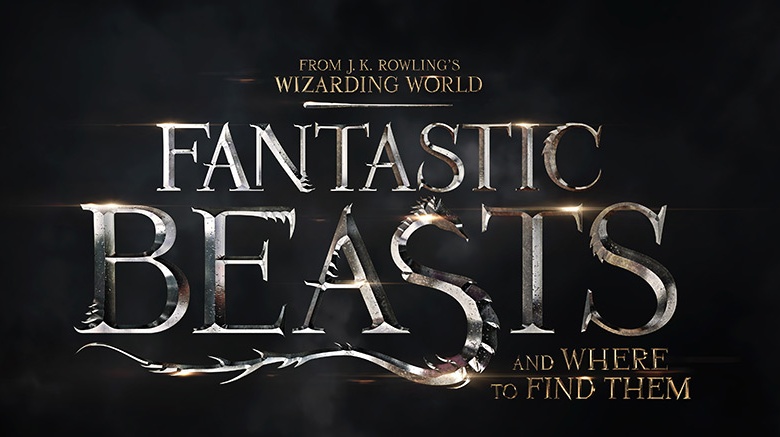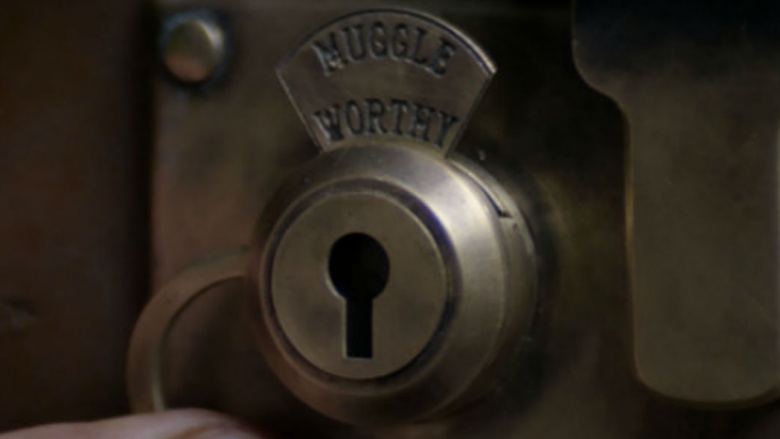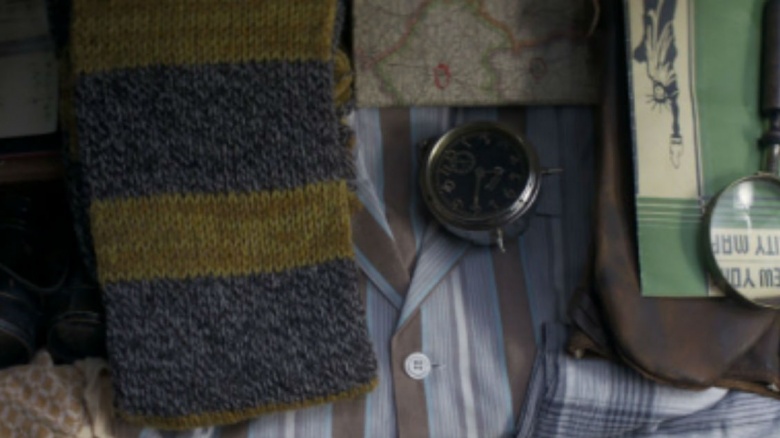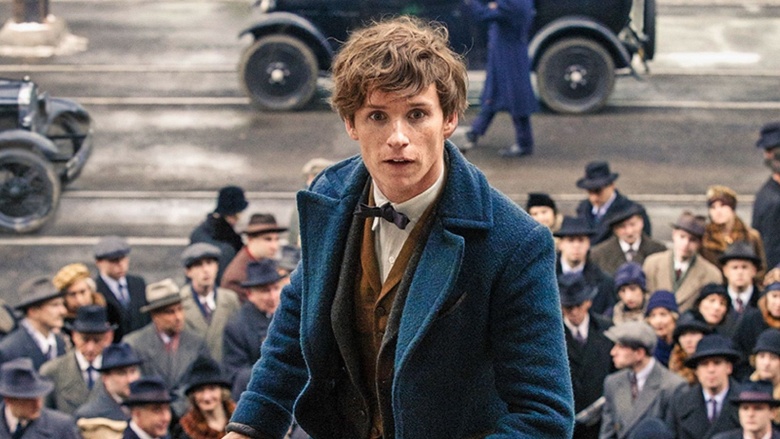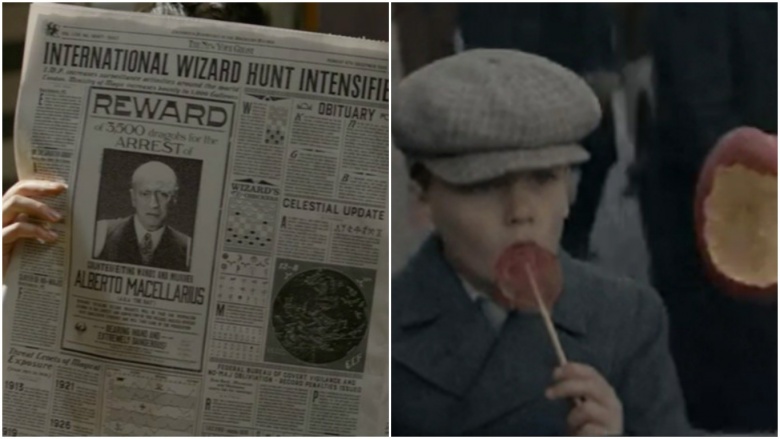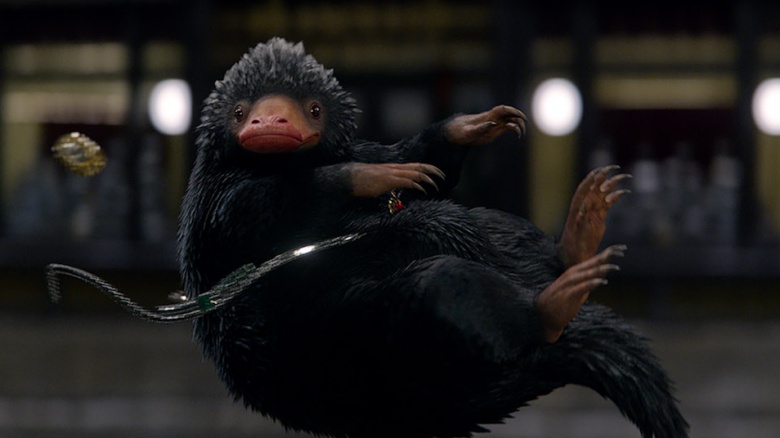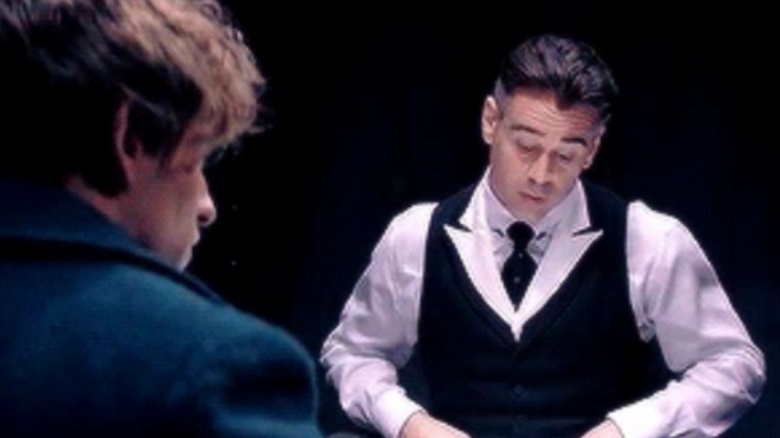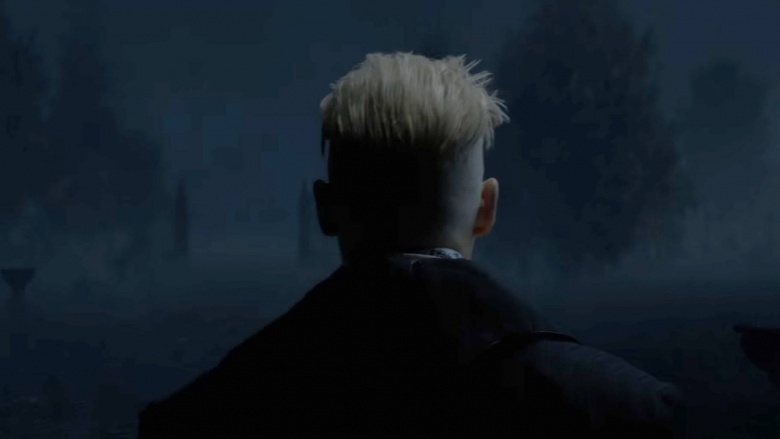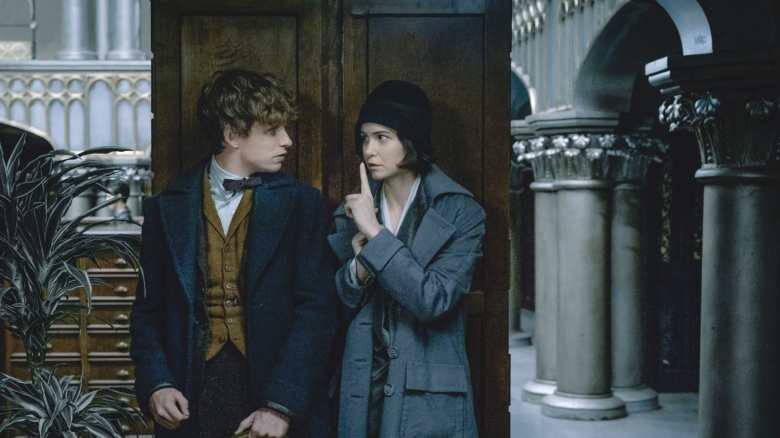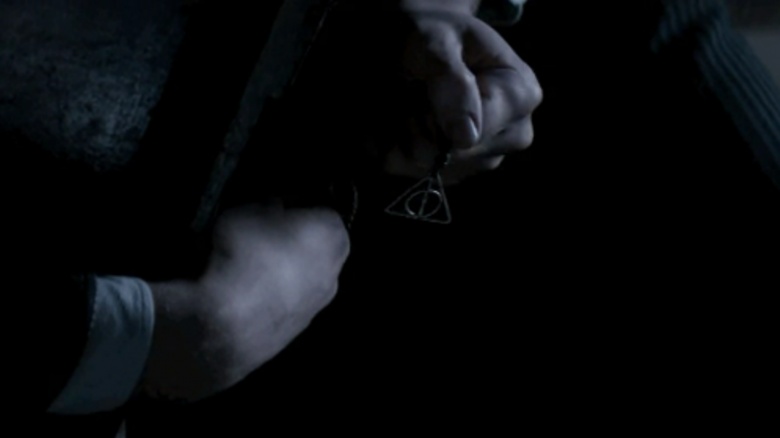Easter Eggs In Fantastic Beasts And Where To Find Them
Cue "Hedwig's Theme," because Harry Potter is back! Well ... sort of. The Boy Wizard isn't gracing the big screen again—instead, the Wizarding World as we know it has magically expanded to shed some lumos light on one of its previously little-known characters: Newt Scamander.
J.K. Rowling committed pen to paper to write the script for Fantastic Beasts and Where to Find Them and introduce a fuller version of Newt—a guy previously only known in the Potter universe for writing a wizarding textbook and inexplicably showing up in the Marauder's Map that one time during Prisoner of Azkaban. And while the new series starter introduced a distinct time, setting, characters, and even vocabulary elements, there were some subtle nods to the Harry Potter faithful you might've missed.
Making a name
The biggest tie-in between Scamander and the Potter universe—well, apart from him being a wizard, of course—is the fact that he once wrote the book on magizoology that would later be taught at Hogwarts School of Witchcraft and Wizardry (and obtain its own release to the muggle world via Rowling's Hogwarts Library books).
Fantastic Beasts takes place long before Newt's anthology would become canon, so it was something of a nod to the Potter realm that Newt's new gal pal Porpentina ("Tina") refers to his as-yet-unfinished manuscript as Fantastic Beasts and Where to Find Them, which would eventually become its name. It's something of a gimme reference, considering how ubiquitous that title is, but it's still pertinent nonetheless.
The intro
Another obvious homage to the Harry Potter series that helped establish this new glimpse into the Wizarding World is the opening to Fantastic Beasts, which includes those familiar fanciful chords and metallic lettering. There were some adjustments—a basilisk coming in as the "S" and some razor-sharp teeth scattered throughout the other letters—but the callback to the first magical run is multisensory from the start.
The tiny-giant suitcase
Newt's suitcase having a limitless interior size was certainly a callback to things we'd seen in the Harry Potter series before. Consider how massive the Weasleys' Quidditch World Cup tent was on the inside, or how Hermione could fit literally anything—even a pop-up dwelling—inside her sack while she and Harry were on the run in Harry Potter and the Deathly Hallows. (Between this and the self-washing dishes, it's hard to say which would be more handy.) The visual element of the attache being opened by prying claws too, seemed like a distinct wink to that sassy The Monster Book of Monsters that tormented Harry in Harry Potter and the Prisoner of Azkaban—the claws in each look almost exactly the same.
Hufflepuff pride
Even though he's no longer in good standing within the halls of Hogwarts, Newt Scamander obviously doesn't hold anything against his old house, as evidenced by the Hufflepuff-colored scarf tucked away in his briefcase (on the muggle-friendly setting only, of course). It's a good thing he's not bitter towards his old institution, because we know his future grandson, Rolf, is due to marry Luna Lovegood down the line and make a few Scamander babies to carry on Newt's creature-loving legacy. Maybe the next few films will feature his triumphant return to the school? Certainly his mastery of the magizoology game should earn him some favor with the Ministry.
Quidditch quip
Quidditch was a source of levity and lighter fancy throughout the Harry Potter series, and Newt pays a tiny homage to the sport by mentioning that he's "more of a chaser, really" in response to an unrelated question of whether he was a seeker. What he's referring to is, of course, his choice of field position, and even though it was out of context, Potter fans can certainly recognize it as a nod to the sport. (Side note: Perhaps if he had spent more time seeking the Snitch, it would've prepared him for the beast-grappling duties in this installment?)
Merlin's beard!
Even though American muggles are called "no-majs" and there's plenty of other new terminology to take in during Fantastic Beasts, there's one utterance that's a direct replica of something said back in the Harry Potter days: "Merlin's beard!" You might recall hearing that at least twice from Cedric Diggory's dad Amos and Horace Slughorn in the prior films, but the expression's popularity as a colloquialism for surprise in the Wizarding World has obviously lasted through several generations ... although, sadly, the Weasleys' colorful adaptations of the phrase didn't make it into the new movie.
It was just one of several callbacks to the cheekier bits from the Potter-verse—the chaotic highway sequence was also a lot like what went down with the Knight Bus, the newspaper images floating around with a wanted criminal on display (might this wanted wizard Alberto Macellarius might be the new Sirius Black?), the use of the "Alohomora" spell, the tiny doorways to the wizarding community lurking around muggledom/no-maj space. Even the clock that measures danger at the Magical Congress of the United States of America might be a nod to the Weasleys' location monitor, and the floating apple that eats itself in front of the boy is a callback to the scene when Harry used the invisibility cloak to sneak into Hogsmeade and walk around with a red lollipop.
Behold, the Niffler!
The niffler might be new to the big screen with Fantastic Beasts, but the adorable mole-duck-porcupine-mix creature has long existed in the written realm of magic. Although the fantastic beast never made the cinematic cut for Harry Potter and the Goblet of Fire, director David Yates made sure to give him adequate screentime in Fantastic Beasts and make everyone who has a niffler as their patronus squeal with delight. Other creatures who'd been mentioned before but only made their screen debut in Fantastic Beasts included the size-shifting Occamy and the disappearing Demiguise.
Dumbledore's back (probably)
We don't get to see the fawkes-friendly Dumbledore in Fantastic Beasts, but he does get a major mention that proves he's alive and well in this timeline. It seems Newt fell from grace at Hogwarts much like future fellow fantastic beast-lover Hagrid (although, to be fair, the spider Aragog didn't actually kill Moaning Myrtle). Dumbledore tried to stick up for him, but he was expelled all the same.
The mention is crucial because it sets the stage for what is sure to be an emotional, difficult, yet still triumphant return for a much-younger version of the Hogwarts icon, as he witnesses (and stops) the first attempted rise of autocracy in the Wizarding World by way of Gellert Grindelwald. On that note ...
Gellert Grindelwald is also definitely back
Polyjuice Potion impersonations ran rampant throughout the Harry Potter series, so perhaps the big twist in Fantastic Beasts—that is, that Gellert Grindelwald had disguised himself as Auror Percival Graves throughout most of the events of the movie—shouldn't have been a surprise. However, the reintroduction of Grindelwald certainly sets the stage for some interesting character history deep dives to come (which is likely, considering there are four more movies planned for this new series), especially when it comes to Professor Dumbledore.
In Harry Potter and the Deathly Hallows, the character was presented in retrospect, as he and Dumbledore had fostered a friendship and shared plans to recover the Deathly Hallows (the Elder Wand, the Cloak of Invisibility, and the Resurrection Stone) to make the world safer and freer for wizards before Grindelwald broke bad and killed Dumbledore's little sister Ariana. His eventual duel with Dumbledore would be his undoing after he committed unthinkable acts with Dark Arts. There's a lot to unpack with their history, so his introduction seems like a beginning, rather than an end.
Lestrange family history
The Lestrange family became a major part of the mayhem that arose at Lord Voldemort's end, but Fantastic Beasts proves there was more to their backstory than we might've guessed. Before Bellatrix and Narcissa carried the family into complete nefariousness under the Dark Lord's direction, there was Leta. Leta LeStrange doesn't get much love in the first Fantastic Beasts movie, but we find out she was a former friend/flame of Newt's who betrayed him somehow and exists as "a taker," according to Queenie and her legilimency gifts. Newt keeps a picture of her at his desk, but even he knows "people change"—whatever that means.
There's no doubt Leta will have some familial connection with Bellatrix and Narcissa, but what exactly that relationship is has yet to be explored. Considering Bellatrix goes on to have Voldemort's only child in Cursed Child, could Leta be a future mother-in-law-ish figure to the Dark Lord himself? Could she be a key figure in his rise, too? With four more films to go, we're sure to see more from her, especially now that Gellert Grindelwald is ready to stake his claim for a new world order.
The Deathly Hallows
If there's one thing that could not be hidden during Fantastic Beasts it's the symbolism of the Deathly Hallows. Percival Graves (well, Grindelwald in Graves' skin, at least) gives Credence a Deathly Hallows necklace much like the one Xenophilius Lovegood sported in the Harry Potter movies. This is a clear reminder that the Deathly Hallows were still a highly sought-after trio of powerful objects, and that the epic battle to come between Grindelwald and Dumbledore is predicated on the existence of these objects and the power their owner might wield above other wizards. The Fantastic Beasts battle for control is only the beginning of the first long and hard-fought battle between a megalomaniac (Grindelwald) and a broker of peace (Dumbledore).

